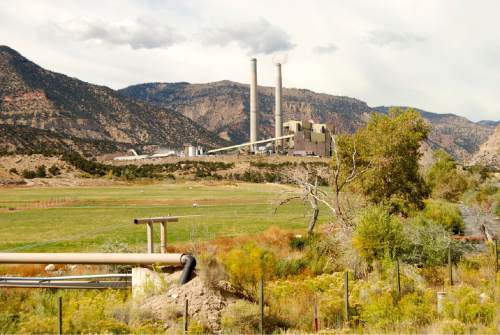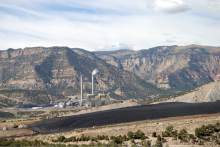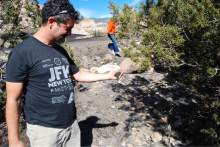This is an archived article that was published on sltrib.com in 2015, and information in the article may be outdated. It is provided only for personal research purposes and may not be reprinted.
Huntington • Millions of tons of coal ash waste stored near a central Utah power plant have been contaminating nearby water resources for years in violation of federal environmental laws, according to an investigation led by an environmental group.
According to a letter HEAL Utah's lawyer sent to the company's parent, PacifiCorp, last week, Rocky Mountain Power is illegally impounding water that flows from two canyons and picks up dangerous pollutants produced from burning coal in the Huntington Power Plant.
"They botched the disposal operation from the start. They throw the waste into unlined landfills that have leaked all over the place," said attorney Richard Webster of the nonprofit law firm Public Justice. "They have a number of [state] permits in place that should have addressed this issue. Instead of enforcing these conditions, the state allowed them to move the contamination around."
The utility contends the HEAL allegations are the based on incorrect assumptions.
"Concerns raised that are actual issues have been identified because they are available in the public records, having been reported by PacifiCorp to the Utah Department of Environmental Quality," the utility said in a prepared statement. "These issues have been addressed or are currently being addressed with the oversight of the Department of Environmental Quality. PacifiCorp continues to ensure that the facility remains in compliance with the recently finalized coal combustion residual rules and all requirements of the Clean Water Act."
Each year, Huntington generates about 320,000 tons of coal ash, a powdery waste rich in boron, arsenic, lead, cadmium and other toxic heavy metals. Technically known as coal combustion residuals, this ash is the nation's largest waste stream of hazardous substances, totaling 121 million tons last year.
RMP's management practices have contaminated the groundwater near the two-unit 960-megawatt plant, which has operated at the mouth of Huntington Canyon in Emery County since 1973, the letter alleges. Contamination escapes into Huntington Creek, whose water quality is already classified as impaired.
The 13-page letter is a notice of intent to file a citizen suit seeking to enforce provisions of the Clean Water Act and the Resource Conservation and Recovery Act. If PacifiCorp does not take steps to contain and cleanup the pollution in the next few months, HEAL and the Sierra Club will file suit in U.S. District Court.
The letter also highlights a pile of pulverized coal covering 30 acres of utility property on the other side of Huntington Creek from the plant. There are no structures or berms to contain runoff from the pile, which is shedding coal dust onto lands surrounding the fenced property.
HEAL executive director Matt Pacenza discovered the coal pile last May while on a trip looking into the coal-ash contamination.
"One of us turned around and thought, 'What the hell is that?' It is instantly apparent the utility just doesn't care if its product is blanketing the land and water," Pacenza said during a return visit a week ago. "You can see black rivers that have flowed down from a pile that doesn't have the vaguest hint of storm water protections. Here we have tons of coal above a creek that is already in trouble, and it doesn't look like they put a penny or any thought into safeguarding the public from the runoff."
To make his point, he picked up handfuls of the black grains that had gathered in a wash down-gradient from the pile, itself incised where rainwater had eroded runnels down its 20-foot-high flanks. He let the coal pour from his hand to show how concentrated the powder was.
RMP says coal has been stockpiled at this location since 2007 and it currently holds 620,000 tons.
"The site is permitted by the state and managed in compliance with environmental regulations. Its purpose is to hold a coal stockpile for Huntington plant for both inventory and blending for overall fuel quality," RMP spokesman Dave Eskelsen wrote in an email.
Utah's largest utility, RMP relies heavily on coal to generate electricity, though its portfolio has been shifting toward natural gas and renewable sources in recent years.
New federal rules take effect Monday governing the management of coal ash.
Until this year, the Utah DEQ had no authority to regulate coal ash, according to Scott Anderson, director of the agency's waste management division. But lawmakers reclassified it this year as a "solid waste" to enable DEQ to impose its own rules on Utah utilities and other coal-ash generators.
The agency is now drafting rules, but in the meantime, Utah coal ash will fall under the new federal rules.
The U.S. Environmental Protection Agency adopted the rules under legal pressure from the nonprofit law firm Earthjustice following a 2008 coal ash slurry release in Tennessee, believed to be the largest toxic spill in U.S. history.
"States like Utah had absolutely no regulations on the books. The West is devoid of rules, even though coal ash behaves as a hazardous waste. It contains dangerous chemicals," said Lisa Evans, Earthjustice senior counsel on coal-ash issues. "When disposed of improperly, the chemicals will dissolve out of ash into groundwater, and can contaminate air and soil. It must be disposed of in an engineered landfill and isolated. In Utah, it appears they have done exactly the opposite."
She said coal ash piles are inherently unstable, and locating them near water is "a recipe for disaster."
HEAL's allegations are based on studies the utility itself commissioned while it was undergoing state permitting for groundwater and surface water discharge permit a few years ago. RMP's consultants detected astronomically high levels of boron, nitrates and total dissolved solids in the groundwater.
Instead of completing the permit process, the utility invented a work-around where polluted discharge from a canyon was captured before it could reach Huntington Creek, HEAL alleges. Capturing this flow would require a permit from the U.S. Army Corps of Engineers, but there is no evidence RMP sought one, Webster said.
This contaminated water was stored in a pond on the opposite side of the creek, then fed into pipes that irrigated agricultural fields RMP maintains for research purposes.
Documents obtained through a public records request to DEQ show this water exceeded standards for boron, a marker for coal-ash contamination.
"There are likely other toxic ions, like arsenic, cadmium led and chromium. The state hasn't required them to measure for those contaminants, but we are certain they are there," Webster said. "Boron is a highly soluble contaminant that moves quickly though the ground."
The state signed off on RMP's "elaborate engineering schemes," which accomplished nothing to protect the environment other than rearranging the pollution around, the groups allege.
HEAL and Sierra Club insist the plant must prevent further contamination of the groundwater and contain runoff from the coal pile.
"What's important is they stop adding to the problem. The next step is to clean up the problem, but they are in denial that they have a problem," Webster said.
Brian Maffly covers public lands for Salt Lake Tribune. He can be reached at brianmaffly@gmail.com or 801-257-8713.
Twitter @brianmaffly







